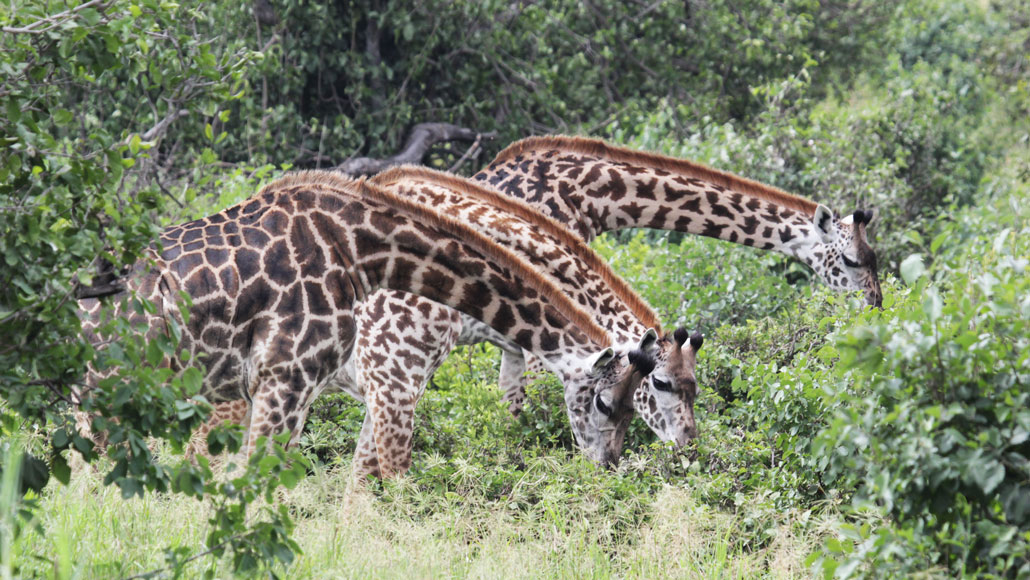
More gregarious female giraffes tend to live longer than those seen in sparse company, a study from Tanzania's Tarangire region shows.
Derek Lee
Grown-up giraffes just aren’t huggy, cuddling, demonstrative animals. So it took identity-recognition software grinding through five years of data to reveal that female social life matters to survival.
The more gregarious adult female giraffes in northern Tanzania’s Tarangire ecosystem tend to live longer, concludes wildlife biologist Monica Bond of the University of Zurich. Females that typically hung around at least three others of their kind, were more likely to outlive those with fewer routine companions, Bond and colleagues report February 10 in Proceedings of the Royal Society B.
In published science, the idea that giraffes even have social lives isn’t much more than a decade old, Bond says. (For the time being, Bond still treats giraffes as one species, Giraffa camelopardalis, until there’s more agreement on how many species there are.) Adult males spend most of their time in solitary searches for females willing to mate, but females often hang around in groups.
Compared with bats clustering under a bridge or baboons grooming pals’ fur, even the most sociable female giraffes often look as if they just happen to be milling around feeding in the same shrubbery. These “loose” groups, as Bond describes them, don’t snuggle or groom each other. A group mostly just browses in the same vicinity, then may fray apart and reconfigure with different members in the fission-fusion pattern seen in many animals, such as dolphins. Yet closer looks have found that females, in their low-drama way, prefer certain neighbors and seem to avoid certain others.
Bond encountered giraffes in the wild in 2005 on her first trip to Africa. “I loved everything,” she says, but especially giraffes looking “as fanciful and weird as a unicorn.” To examine their lives, she and colleagues have now recorded sightings for nearly 3,000 individuals in the Tarangire region. Each giraffe’s spots are unique and remain identifiable throughout life, so photographs of the animals’ torsos make identification possible (SN: 10/2/18).
Unlike Africa’s much-studied Serengeti National Park, the Tarangire region lets researchers watch animals across a wide range of human impacts. At the low-impact end, giraffes munch acacia trees in protected parkland or stroll under baobab trees that are “sticking up like a giant broccoli,” Bond says. Human influence becomes more common where the Maasai people tend their cattle, and the heaviest human footprints lie in the region’s bustling towns.
Bond and her colleagues looked at how the kinds of plants eaten, soil types, closeness to humans and other factors affected females’ chances of surviving from one season to the next. The most important predictor of survival for 512 adult female wild giraffes was the number of other females typically found around them. She doesn’t think it’s just that loners or some straggly groups get more easily picked off by predators. In this region, lions don’t hunt in the big prides that can overwhelm adult prey and “a giraffe can kick a lion to death,” Bond says.
Instead, Bond speculates that gregarious females might suffer less stress. Lions in the area stalk giraffe calves, for instance. In a bigger group, calves can cluster near each other in creches that a few females watch over, letting the other moms get a break. And when bigger female groups settle down at night, Bond sees some alert eyes among the drowsy ones that will get better rest.
This analysis, however, comes from just the Tarangire region. “It would be great for the methods to be replicated in other ecosystems to see how it holds up,” says Arthur Muneza, the east Africa coordinator based in Nairobi, Kenya, for the Giraffe Conservation Foundation. A place where giraffes need to travel farther to find water or other vital resources, for instance, might make a difference in the results.






